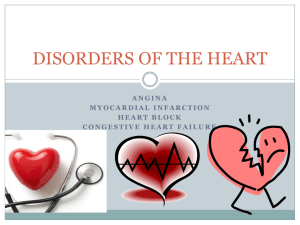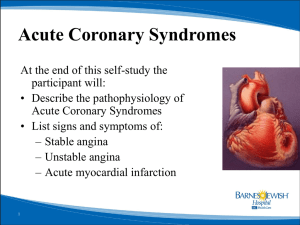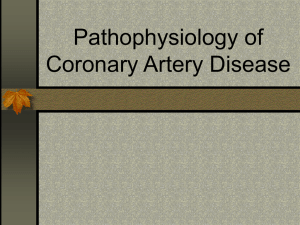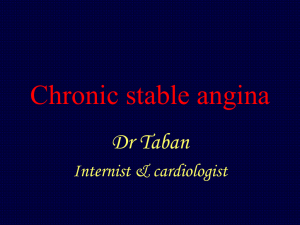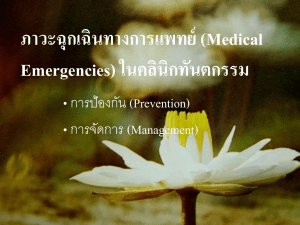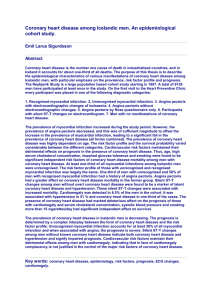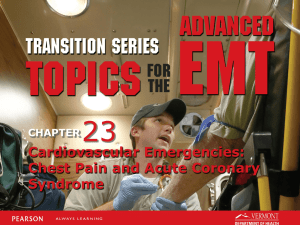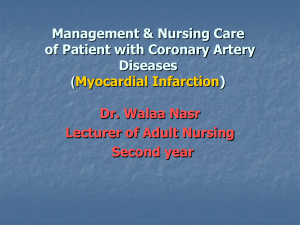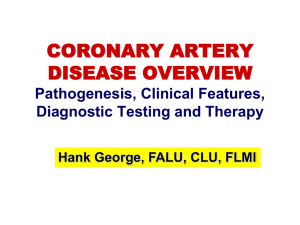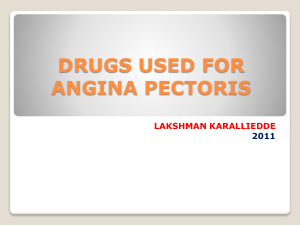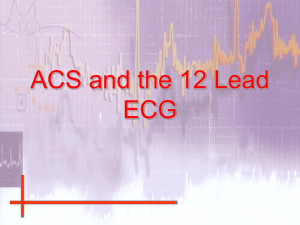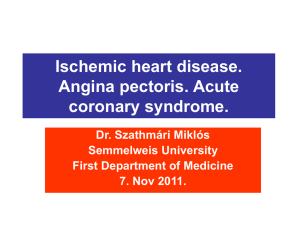G-0967 Coronary Heart Disease, Myocardial
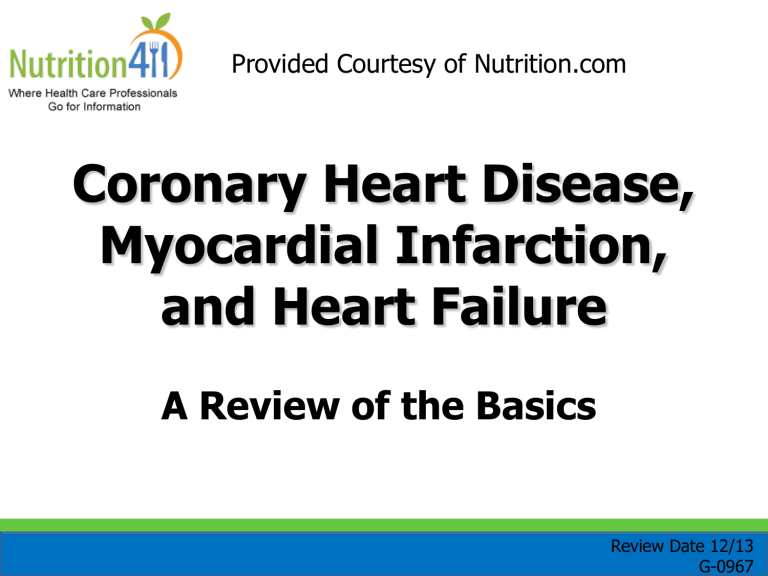
Provided Courtesy of Nutrition.com
Coronary Heart Disease,
Myocardial Infarction, and Heart Failure
A Review of the Basics
Review Date 12/13
G-0967
Defining Heart Disease
Heart disease is a broad term used to describe a range of diseases that affect your heart, such as:
• Coronary heart disease (CHD)
• Atherosclerosis
• Myocardial infarction (MI)
• Heart failure (formerly called congestive heart failure)
Risk Factors for CHD and MI
• Smoking
• High intake of alcohol
• Obesity
• Sedentary lifestyle
• Diabetes
• Hypertension
Risk Factors for CHD and MI (cont’d)
• More than 34 years of age for males and
55 years of age for females (risk increases after menopause)
• Family history—genetics
• Hypertension
• Stress
• Chronic kidney disease
Risk Factors for CHD and MI (cont’d)
• High low-density lipoprotein (LDL) cholesterol
• Low high-density lipoprotein (HDL) cholesterol
• Left ventricular hypertrophy
Risk Factors for Heart Failure
• Obesity
• Hypertension
• Overweight or obesity
• Ischemic heart disease
• Changes in cardiovascular structure, such as diseases to the heart valves or muscle
Coronary Heart
Disease: An Overview
• Blood flow to the vessels surrounding the heart is blocked
• The major underlying cause of CHD is atherosclerosis or a buildup of plaque in the arteries
Plaque Development
• Many factors speed up plaque development:
̶ Elevated cholesterol and triglyceride levels
̶ Hypertension
̶ Infection that initiates the inflammatory response
̶ Elevated iron levels—carry free radicals that damage lining
̶ Elevated homocysteine level
̶ Cigarette smoking
̶ Diabetes
̶ Obesity
̶ Oxidized (LDL) levels
The Atherosclerotic
Process
• Buildup of smooth muscle cells, macrophages, and lymphocytes
• Smooth muscle cells form a matrix of connective tissue
• Lipid and cholesterol accumulates in the matrix
The Atherosclerotic
Process (cont’d)
• Lipid deposits and other materials (including cellular waste, fibrin, and calcium) build up and form a plaque
• After injury, platelets adhere to the arterial wall and release growth factors, which promote lesion development
Coronary Heart Disease
Development
• Steps to development of CHD:
̶ Fatty streaks form, often in people younger than
30 years of age
̶ People are asymptomatic during this first stage of CHD
̶ Plasma LDL enters the injured endothelial wall and forms a plaque that sometimes is prone to rupture
̶ Acute, complicated lesions with rupture and either nonocclusive or occlusive thrombus form (occlusive form often results in MI and sudden death)
̶ Hemorrhage into plaque produces thrombi—thrombus formation with arterial lumen initiated
Coronary Heart Disease
Development (cont’d)
• Steps to development of CHD (cont’d):
̶ Progressive narrowing of lumen
̶ Insufficient blood flow to myocardium (ischemia) results
̶ Chest pain or angina pectoris occurs
Signs and Symptoms of
Coronary Heart Disease
• Chest pain
• Hypertension
• Increased pulse
• Increased respiration
• Dyspnea on exertion
• Pallor of skin
• Light-headedness with exertion
• Diminished peripheral pulses
• Intermittent claudication—cramping of the lower extremities
Treatment of Coronary
Heart Disease
• Antihyperlipidemic agents
• Medications that lower triglycerides
• Antiplatelets (aspirin)
• Antihypertensives
• Antianginals (nitroglycerin)
• Antimicrobials
Angina Pectoris:
An Overview
• Chest pain caused by myocardial ischemia from reduced blood flow and/or reduced oxygen supply to the myocardium
• Angina is a warning sign that a heart attack (MI) may occur
Angina Pectoris:
An Overview (cont’d)
• Aerobic metabolism switches to anaerobic metabolism:
̶ Lactic acid buildup
̶ Release of histamine, bradykinins, and enzymes, which stimulate nerve fibers in the myocardium, sending pain impulses to the central nervous system
Angina Pectoris:
An Overview (cont’d)
• Other causes of decreased oxygen supply to the myocardium:
̶ Congestive heart failure
̶ Congenital heart defects
̶ Pulmonary hypertension
̶ Left ventricular hypertrophy
̶ Cardiomyopathy
̶ Severe hypertension
̶ Narrowing of the aortic valve
Angina Pectoris:
An Overview (cont’d)
• Other causes of decreased oxygen supply to the myocardium (cont’d):
̶ Leakage of the aortic valve
̶ Ventricle wall thickening
̶ Atheroma leading to arterial narrowing
• Silent ischemia—decreased oxygen supply with no pain
Causes of Increased
Oxygen Demand
• Causes of increased oxygen demand on the myocardium:
̶ Anemia
̶ Exercise
̶ Thyrotoxicosis
̶ Substance abuse, particularly cocaine
̶ Hyperthyroidism
̶ Emotional stress
Four Types of Angina
• Stable:
̶ Caused by specific amount of activity
̶ Predictable
̶ Relieved with rest and nitrates
• Unstable:
̶ Pain occurs with increasing frequency, severity, and duration over time
̶ Unpredictable
̶ May occur at rest
̶ High risk for MI
Four Types of Angina
(cont’d)
• Prinzmetal’s (variant):
̶ Has no identified cause
̶ May occur at same time of day
̶ May intensify or worsen over time
̶ Is usually caused by coronary artery spasm
• Angina decubitus:
̶ Occurs when a person is lying down with no cause
̶ Occurs because gravity redistributes body fluids
Signs and Symptoms of Angina
• Pressure or heaviness in chest beneath breastbone—women are likely to have unusual types of chest discomfort
• Pain may occur down shoulder or inside of arms, or in the throat, jaw, or teeth
• Stomach pain, especially after eating
• Sweating
Signs and Symptoms of Angina (cont’d)
• Light-headedness
• Hypotension
• Pulse changes
• Indigestion
Treatment of Angina
• Antianginals (nitroglycerin)
• Antiplatelets (aspirin)
• ACE inhibitors
• Beta-blockers
• Calcium channel blockers
• Thrombolytic therapy (if thrombi are the cause)
• Oxygen administration
• Percutaneous transluminal coronary angioplasty or coronary artery bypass graft to prevent MI
Myocardial Infarction:
An Overview
• Death of cells in the myocardium, usually related to prolonged or severe ischemia
• Necrosis, tissue damage, and sometimes death results
• Cause of MI include:
̶ Sudden onset of ventricular fibrillation
̶ Embolus (most common cause)
̶ Thrombosis
̶ Atherosclerotic occlusion
̶ Prolonged vasospasm
Myocardial Infarction
Progression
• Cellular injury occurs from lack of oxygen:
̶ If prolonged, will lead to cell death
• Scar replaces muscle, but cannot contract or conduct impulses:
̶ Location of damage is determined by which artery is blocked
• Damage begins at subendocardial level:
̶ Will progress to the epicardium within 1 to 6 hours
Myocardial Infarction
Progression (cont’d)
• Damaged cells lead to decreased contractility:
̶ Less blood ejected by left ventricle with each beat
̶ Decreased blood pressure
̶ Decreased tissue perfusion
Myocardial Infarction:
Signs and Symptoms
• Pain, typically in middle of chest, radiating to jaws, arms (usually the left), abdomen, and/or shoulders, and lasting 20 minutes:
̶ Possible to have no pain or atypical pan (particularly in females)
̶ Sudden onset of pain, not associated with activity
Myocardial Infarction:
Signs and Symptoms
(cont’d)
• Tachycardia
• Excessive perspiration
• Painful breathing and/or difficulty breathing
• Anxiety/panic
• Nausea/vomiting
• Fever
• Stomach pain, often confused with indigestion
Laboratory Evaluation
• Creatinine kinase
• Trophin
• Myoglobin
Myocardial Infarction
Complications
• If more than 50% of heart tissue is damaged, severe disability or death will result
Myocardial Infarction
Complications (cont’d)
• Pericarditis may develop up to 2 months later:
̶ Fever
̶ Pericardial effusion
̶ Pleurisy
̶ Pleural effusion
̶ Joint pain
̶ Rupture of heart muscle
̶ Ventricular aneurysm
̶ Blood clots
̶ Hypotension
Treatment Following
Myocardial Infarction
• Antianginals (nitroglycerin)
• Analgesics
• Electrolyte replacement
• Calcium channel blockers
• Beta-blockers
• Antihypertensives
• Anticoagulants
Treatment Following
Myocardial Infarction
(cont’d)
• Antiarrhythmics
• Thrombolytics
• Oxygen
• Mild antianxiety agents
Heart Failure:
An Overview
• Inability of the heart to pump sufficiently to meet metabolic needs, leading to decreased tissue perfusion as a result of decreased cardiac output
• Acute or chronic
• Left sided or right sided
• Systolic or diastolic
Causes of Heart Failure
• Hypertension
• MI
• Cardiomyopathies
• Congenital heart disease
• Valve disorders
• Side effect of medication or alcohol
Types of Heart Failure
• Systolic dysfunction:
̶ Heart contracts with less force and cannot pump out as much blood to the rest of the body as normal
̶ Blood accumulates in the ventricles and veins
• Diastolic dysfunction:
̶ Heart is stiff and does not relax after contracting
̶ Heart does not allow as much blood to enter its chambers from the veins, and the blood accumulates in the veins
Types of Heart Failure
(cont’d)
• Left sided:
̶ More common
̶ Fluid backs into lungs
̶ Signs and symptoms include:
• Fatigue
• Activity intolerance
• Dizziness
• Syncope
• Dyspnea
• Coughing
• Pulmonary crackles
• Tacycardia
• urine output
• Shortness of breath when lying down
Types of Heart Failure
(cont’d)
• Right sided:
̶ Caused by pulmonary hypertension or right ventricular infarction
̶ Fluid backs into rest of body, with abdominal organ congestion and peripheral edema
̶ Signs and symptoms include:
• Lower extremity edema in the ambulatory
• Sacral edema in the bedridden
• Liver engorgement and right upper quadrant pain
• Anorexia and nausea
• Jugular venous distension
Types of Heart Failure
(cont’d)
• Biventricular (signs and symptoms of both left and right heart failure):
̶ Signs and symptoms include:
• All symptoms of right and left heart failure
• Dyspnea at rest
• Hepatomegaly and splenomegaly
• Abdominal pressure
• Ascites
• Anorexia
• Nausea and vomiting
• digestion and absorption of nutrients
• Dysrhythmias
• Cardiogenic shock or acute pulmonary edema
Cardiac Cachexia
• 10% to 15% of patients with heart failure develop cardiac cachexia
• Loss of 6% of nonedematous body weight over 6 months
• Concurrent loss of cardiac muscle mass as a result
Cardiac Cachexia
(cont’d)
• Many other metabolic changes:
̶ Increased catabolic catecholamines
̶ Tumor necrosis factor is increased, contributing to a lower body mass index and catabolic state
Treatment of Coronary
Heart Disease
• Diuretics
• Dopamine
• Analgesics
• Antihypertensives
• ACE inhibitors
• Direct vasodilators
• Antidysrhythmics
• Cardiac glycosides (digitalis)
• Aldosterone agonists
Treatment of Coronary
Heart Disease (cont’d)
• Antibiotics, if necessary
• Iron supplementation, if necessary
• Supplemental oxygen
• Nitrates
• Beta-blockers
• Anticoagulants
References
Academy of Nutrition and Dietetics. Nutrition Care Manual
[by subscription]. Nutrition Care Manual Web site.
® www.nutritioncaremanual.org
. Accessed December 1, 2013.
Cleveland Clinic. Acute myocardial infarction. Cleveland Clinic Center of
Continuing Education Web site. http://www.clevelandclinicmeded.com/medicalpubs/diseasemanagement/ cardiology/acute-myocardial-infarction/ . Accessed
December 1, 2013.
Cleveland Clinic. Heart failure. Cleveland Clinic Center for Continuing
Education Web site. http://www.clevelandclinicmeded.com/medicalpubs/diseasemanagement/ cardiology/heart-failure . Accessed December 1, 2013.
References (cont’d)
Raymond JL, Couch SC. Medical nutrition therapy for cardiovascular disease. In: Mahan, LK, Escott-Stump S, Raymond JL.
2012:742-781.
Krause’s Food and the Nutrition Care Process.
13th ed. St Louis, MO: Elsevier Saunders;
The Merck Manual for Health Care Professionals. Cardiovascular disorders. Merck Manuals Web site. http://www.merckmanuals.com/professional/cardiovascular_disorders.ht
ml . Accessed December 1, 2013.
What is angina? National Heart, Lung, and Blood Institute Web site. http://www.nhlbi.nih.gov/health/health-topics/topics/angina/ . Accessed
December 1, 2013.
